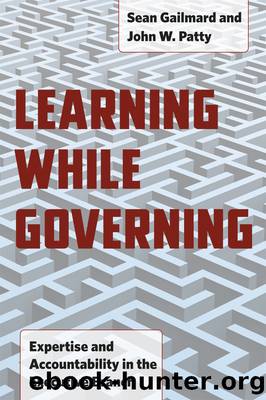Learning While Governing: Expertise and Accountability in the Executive Branch by Sean Gailmard & John W. Patty

Author:Sean Gailmard & John W. Patty [Gailmard, Sean & Patty, John W.]
Language: eng
Format: epub
Tags: Public Policy, National, Political Science, Executive Branch, American Government, General
ISBN: 9780226924403
Google: u4X-IR2329EC
Goodreads: 13593324
Publisher: University of Chicago Press
Published: 2012-12-06T00:00:00+00:00
6.1 The Institutional Presidency in the Federalist Era
Though the institutional presidency is generally understood to be a twentieth century creation, the legislatureâs role in creating institutions to supply the president with high-quality policy information dates to the first Congress in 1789. In creating the four executive departments of Foreign Affairs (later State), War, Navy, and Treasury8 between 1789 and 1798, Congress was creating a rudimentary form of what we now recognize as the âinstitutional presidency.â These departments were capable of serving many of the advisory functions we now ascribe to the institutional presidency, and they had a much more intimate relationship with the president than is now typical of cabinet secretaries.
Scholars studying the modern presidency do not regard cabinet departments as contributing to its institutionalization. Instead, they focus on institutions such as the executive office of the president that are attached to the presidency as such, not charged with line duties of program implementation. Thus, surveys of the institutional presidency beginning with, say, President Theodore Roosevelt indicate that there was none. There are good reasons for this. Even before the federal government assumed undisputed primacy in domestic policy making, executive departments were charged with implementing hundreds of programs and making administrative decisions as applications of established criteria. Line implementation of these programs assumed its own bureaucratic logic and a ground-level orientation distinct from any that might support presidential policy leadership.
However, this situation evolved over the nineteenth century rather than springing from a conscious design. In this section, we will argue that the executive establishment created by statute and by practice in the Federalist era (1789â1801) constituted an institutional presidencyârudimentary by modern standards, perhaps, but still serving many functions we ascribe to the institutional presidency today. We will further argue that the form of these institutional designs was not a foregone conclusion, but that it ultimately reflects the incentives for empowering the president that the Constitution presents to Congress. Consistent with the model in the previous chapter, these incentives stem from a Federalist conception of the constitutional authority of the president in the policy process.
The structure of cabinet departments in the Federalist era is particularly interesting to examine from the standpoint of our model: the separation of powers issues in these cases were likely to be relatively prominent; there were no organized interests or entrenched bureaucracies whose preferences might have been be a factor in structural choices for new agencies; and national politics was not in a period of either weak presidents or compliant Congresses unable to fully defend the interests of the respective branches. Moreover, the administrative slate was relatively blank at this point; there was no standing cadre of agencies with entrenched functions guarding their turf or levels of independence that might influence structural aspects of new agencies. Perhaps most obviously for purposes of comparing these cases, these departments were all created roughly contemporaneously with each other by the same or overlapping groups of legislators; thus, they were created against a common background of perceived constitutional propriety and perceived conflict across branches of government.
Download
This site does not store any files on its server. We only index and link to content provided by other sites. Please contact the content providers to delete copyright contents if any and email us, we'll remove relevant links or contents immediately.
Collaborating with Parents for Early School Success : The Achieving-Behaving-Caring Program by Stephanie H. McConaughy; Pam Kay; Julie A. Welkowitz; Kim Hewitt; Martha D. Fitzgerald(854)
Entrepreneurship Education and Training: The Issue of Effectiveness by Colette Henry Frances Hill Claire Leitch(591)
Adding Value to Policy Analysis and Advice by Claudia Scott; Karen Baehler(487)
Race and American Political Development by unknow(474)
Sociological Perspectives of Health and Illness by Constantinos N. Phellas(468)
American Government and Politics Today by Steffen W. Schmidt Mack C. Shelley Barbara A. Bardes(463)
Human and Global Security : An Exploration of Terms by Peter Stoett(451)
Materializing the Middle Passage by Jane Webster;(443)
Control Of Oil - Hardback by Kayal(435)
Advances in Child Development and Behavior, Volume 37 by Patricia J. Bauer(387)
The Catholic Church and European State Formation, AD 1000-1500 by Jørgen Møller(381)
The World According to China by Elizabeth C. Economy(368)
Left Is Not Woke by Susan Neiman(353)
Theories of Counseling and Psychotherapy: A Case Approach by Nancy L. Murdock(352)
The Disappearance of Rituals: A Topology of the Present by Byung-Chul Han(350)
Turkey's Relations with the West and the Turkic Republics: The Rise and Fall of the Turkish Model by Idris Bal(344)
Application of classical statistics, logratio transformation and multifractal approaches to delineate geochemical anomalies in the Zarshuran gold district, NW Iran by unknow(340)
Cross-Cultural Child Development for Social Workers by Lena Robinson(338)
Japan's Ainu Minority in Tokyo by Mark K. Watson(321)
